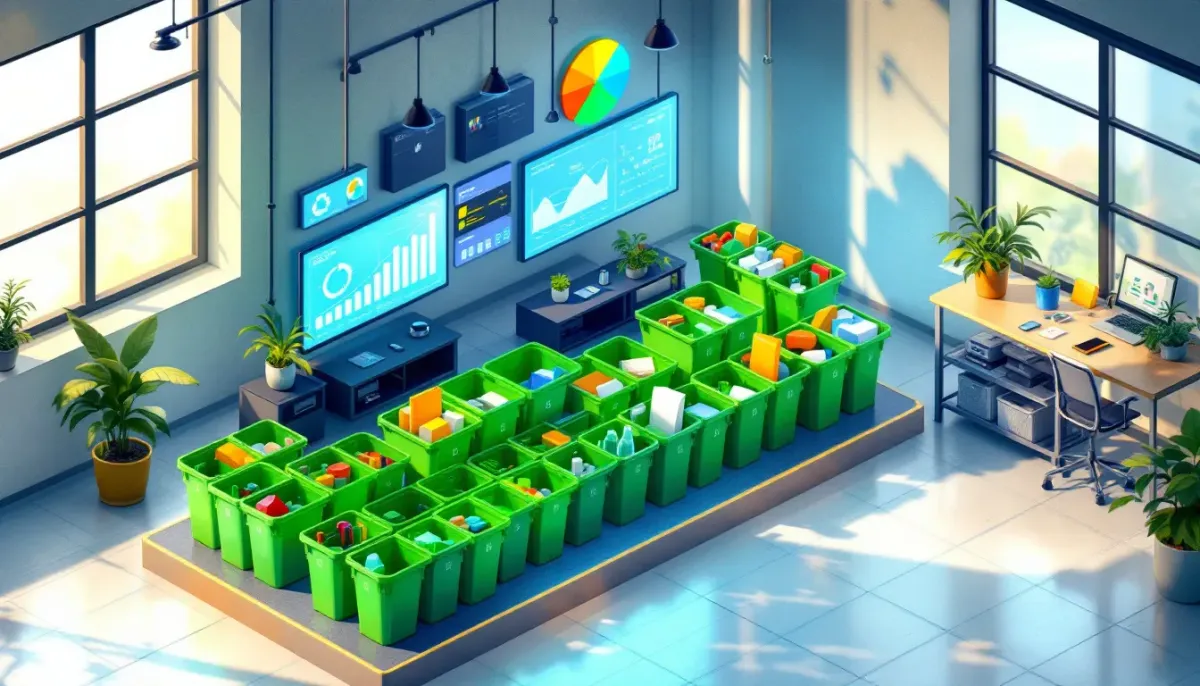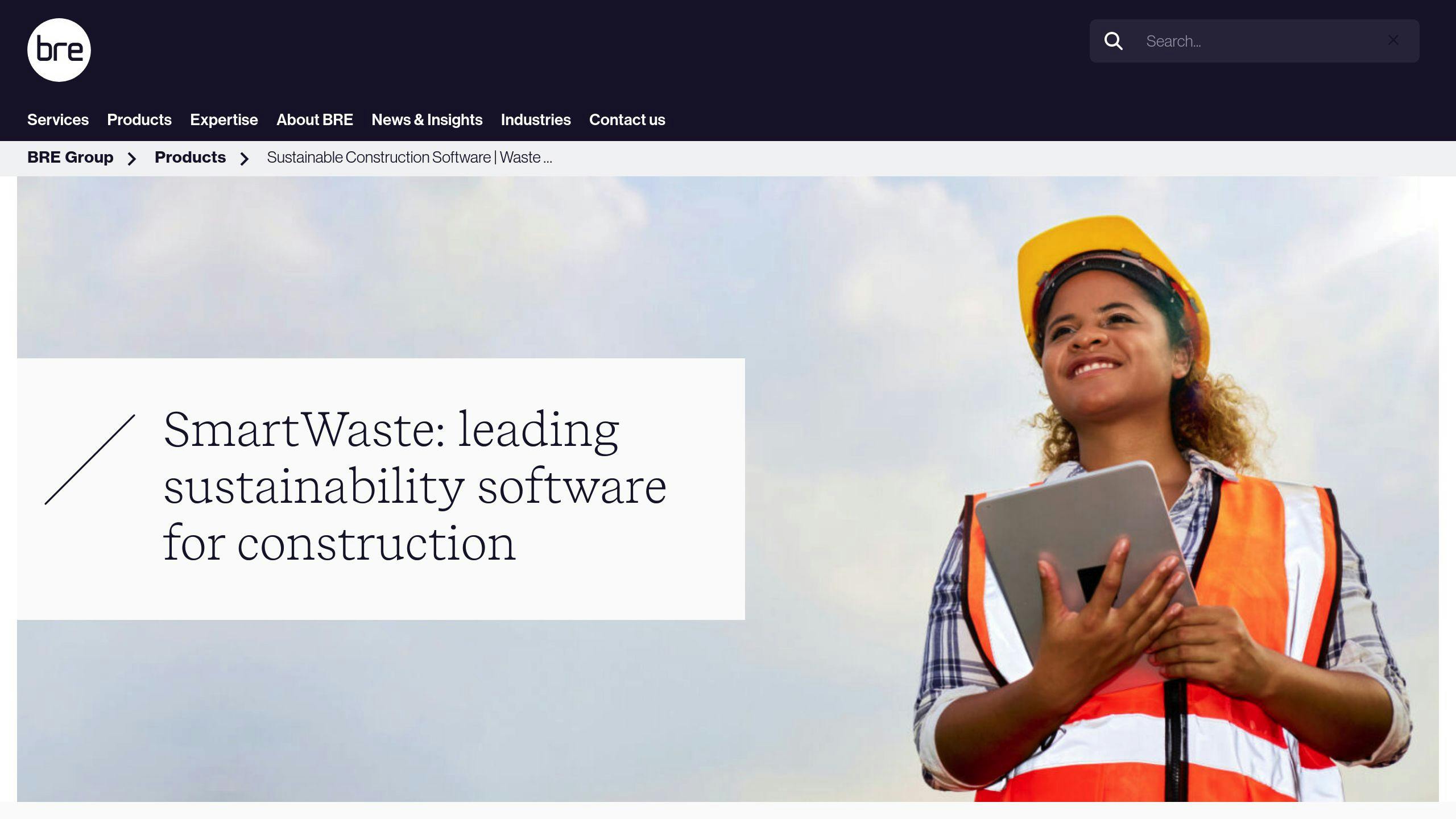Waste Tracking Software: Complete Guide 2024
Discover how waste tracking software can transform waste management, ensuring compliance and efficiency ahead of the 2025 regulations.

Want to ditch paper forms for digital waste tracking? Here's everything you need to know about waste management software in 2024.
Quick Facts:
- Construction produces 3 billion tons of waste yearly worldwide
- UK landfills are 50%+ construction waste (70 million tons/year)
- Digital tracking becomes mandatory in UK April 2025
| Feature | Old Way | New Way |
|---|---|---|
| Forms | Paper | Mobile apps |
| Data Entry | Manual | Automatic |
| Updates | Weekly/Monthly | Real-time |
| Storage | Filing cabinets | Cloud backup |
| Communication | Email chains | Single dashboard |
Core Software Features:
- Live GPS tracking
- Fill level sensors
- Mobile apps for drivers
- Automatic reporting
- Integration with billing
- Route optimization
| Industry | Key Benefits | Cost Savings |
|---|---|---|
| Construction | 40% less over-ordering | £24/month/user |
| Buildings | 80% lower bin costs | 70% faster sorting |
| Cities | 50% collection savings | 45% waste reduction |
Bottom Line: With waste tracking becoming mandatory in 2025, businesses need digital solutions now. Setup costs range £5,000-£22,000 with annual training around £2,000-£5,000. Most teams learn the basics in 3-5 days.
Required Digital Waste Tracking Rules
The UK's switch to digital waste tracking in April 2025 brings new requirements for businesses. Here's what matters:
| Requirement | Details |
|---|---|
| Record Creation | Make digital records before moving waste |
| Unique ID | Each waste movement gets its own tracking number |
| Confirmation Time | Confirm collection and receipt within 2 days |
| Annual Fee | £20 to create records on DEFRA portal |
| Coverage Area | England, Scotland, Wales, Northern Ireland |
Each party has specific jobs in the system:
| Role | What You Need to Do |
|---|---|
| Waste Producer | Set up digital records before collection |
| Waste Carrier | Keep tracking info current during transport |
| Waste Receiver | Log receipt within 2 days |
| All Parties | Maintain up-to-date records |
Here's the problem: 41% of Waste Transfer Notes don't have all the needed info.
The timeline looks like this:
| Date | What Happens |
|---|---|
| 2024 | Optional system starts |
| April 2025 | Everyone must use it |
| 2025-2026 | System rolls out completely |
For Washington State businesses:
- From January 1, 2024: Track if you make 8+ cubic yards of organic waste weekly
- By 2030: Cut organic waste going to landfills by 75%
Construction sites must track:
- Waste types
- Destinations
- Movement times
- Transport details
The numbers show support: 79% of UK businesses want these rules for all household waste types. And 75% back the planned fines for breaking the rules.
Main Parts of Waste Tracking Software
Let's look at how waste tracking software works - and why it matters for your business.
Live Tracking Tools
Modern waste tracking isn't just about counting bins anymore. Here's what today's systems can do:
| Feature | Function | Impact |
|---|---|---|
| GPS Tracking | Shows where your trucks are RIGHT NOW | Cuts fuel costs 15-20% |
| Fill Level Sensors | Tells you when bins need emptying | Stops wasted trips |
| Mobile Apps | Gets data from drivers instantly | Makes reporting simple |
| RFID Tags | Keeps tabs on bins and collections | Gets the numbers right |
Data Tools and Reports
The best part? These systems turn all that data into information you can actually USE:
| Tool Type | What It Does | Why You Need It |
|---|---|---|
| Analytics Dashboard | Shows where waste comes from | Helps cut your costs |
| Custom Reports | Makes paperwork automatic | Keeps you legal |
| Cost Analysis | Shows where money goes | Spots ways to save |
| Performance Metrics | Tracks your goals | Proves what works |
Take Hauler Hero's system. It lets you:
- Pull reports for ANY regulation
- See costs for EACH bin
- Track patterns over time
- Know EXACTLY what routes cost
Working with Other Systems
But here's the thing: Your waste software needs to play nice with your other tools:
| System Type | What You Get |
|---|---|
| Billing Software | Bills that write themselves |
| Fleet Management | Smarter truck routes |
| Customer Portal | Easy pickup booking |
| ERP Systems | Everyone sees the same data |
WAM Software shows this in action. Their system:
- Talks to your accounting
- Makes routes better
- Connects to weighbridges
- Shares data with customers
And the numbers? They speak for themselves. Hotels using these connected systems saw:
- 64% less food waste
- £8,000 saved per year
- 4.8kg less daily waste per site
With the UK producing 200 million tonnes of waste yearly, these tools aren't just nice to have - they're how we keep track of it all.
Key Software Features
Here's what makes waste tracking software work:
Waste Types and Labels
Your software needs to handle waste sorting like this:
| Feature | What It Does | Why It Matters |
|---|---|---|
| Auto-Classification | Puts waste in right groups | Cuts sorting errors by 40% |
| QR Code Labels | Scans waste info instantly | Makes work faster |
| Material Tracking | Monitors bin contents | Helps hit recycling goals |
| Hazard Warnings | Spots dangerous materials | Protects staff |
Look at CloudPital in healthcare - their system groups medical waste clearly, so everything gets the right treatment.
Online Waste Forms
Digital beats paper. Here's why:
| Form Type | Old Way | New Way |
|---|---|---|
| Transfer Notes | Paper forms | Digital signatures |
| Weight Records | Hand typing | Auto-logging |
| Collection Proof | Paper slips | Photos |
| Compliance Docs | Paper files | Cloud files |
Want proof? Waste Accountant users now spend 2 minutes on forms instead of 15.
Tracking Waste Movement
Keep eyes on your waste:
| Tracking Tool | Function | Result |
|---|---|---|
| Chain of Custody | Tracks handovers | Complete paper trail |
| Route Mapping | Finds best routes | Uses 20% less fuel |
| Time Stamps | Records exact times | Better scheduling |
| Status Updates | Shows where waste is | Fixes issues fast |
Just ask Leanpath - their kitchen system watches food waste from start to finish, cutting waste in HALF at commercial kitchens.
Uses in Different Industries
Construction Sites
Construction pumps out 600 million tons of waste each year - double what cities produce from regular trash. But smart software helps cut these numbers down:
| Site Need | Software Solution | Results |
|---|---|---|
| Material Tracking | ConWize | 40% less over-ordering |
| Waste Sorting | SafetyCulture | £24/month/user tracking |
| Compliance Docs | Waste Logics | Live permit tracking |
| Fill Level Alerts | Sensoneo | Stops overflows |
Look at the Kendeda Building project. They didn't just talk - they DID IT. Old slate became walls. Campus trees turned into stairs. That's what happens when you track materials properly.
Building Management
Building managers are ditching old methods for smarter ones:
| Task | Old Way | New Way |
|---|---|---|
| Bin Checks | Walking Around | Smart Sensors |
| Collections | Set Times | Fill Alerts |
| Costs | Paper | Digital Reports |
| Vendors | Phone Calls | Online Portal |
Want proof it works? Bin-E's smart bins cut costs by 80%. Plus, they sort waste 70% faster with built-in sensors that ID materials on the spot.
City and Town Use
Cities aren't just getting bigger - they're getting SMARTER:
| City | Tech | Impact |
|---|---|---|
| Amsterdam | 12,500 Sensors | Cut collection costs 50% |
| San Francisco | Bigbelly Bins | Solar-powered crushing |
| Toronto | CNG Trucks | Cleaner air |
| Arlington | RFID Tags | 45% less waste |
"The path to better recycling rates? Track data, analyze it, then build programs that move the numbers up." - Susan Fife-Ferris, Seattle Public Utilities
Seattle's not just talking. They hit 58% recycling and want 70%. Their new north transfer station includes a reuse centre - showing how good tracking leads to smart moves.
New Tools and Features
Smart Sensors and Devices
Here's what modern bin sensors can do:
| Feature | What It Does | Results |
|---|---|---|
| 3-in-1 Level Sensor | Tells you when bins need emptying | Powers 142,000 homes in Ang Mo Kio-Toa Payoh |
| Tilt Detection | Monitors bin position | Runs 5 years on one battery |
| Heat Monitor | Detects fire hazards | Works straight out of the box |
| Fill Tracking | Shows how full bins are | Drops collection costs by 50% |
The best part? These sensors snap onto your existing bins. No need to replace anything. And they keep working for 5 years before you need to change the battery.
Computer Learning Systems
AI is making waste sorting smarter and faster:
| System | Job | Benefit |
|---|---|---|
| AI Robots | Sort materials | Work non-stop |
| Smart Detection | Find wrong items | Makes fewer mistakes |
| Fill Tracking | Know when to collect | Saves truck trips |
| Route Planning | Find fastest paths | Uses less fuel |
Look at the G-Press system: it squashes waste down to 1/4 size using regular power outlets. That means fewer pickups needed.
Secure Data Systems
Blockchain makes waste tracking clear as day:
| Company | Tool | Output |
|---|---|---|
| Plastic Bank | Digital tokens | Will track 1B kg plastic (2025) |
| RecycleGO | Green Points | Gives rewards for recycling |
| BanQu | Chain tracking | Shows where materials go |
"IoT, blockchain and AI in recycling isn't just about better numbers - it's about smarter waste handling." - Thomas Sander, Author
Want proof? Check out RM2's BLOCKPal pallets. Their IoT tracking shows each pallet lasts 162 uses. For every million trips, they cut CO2 by 640 metric tons per year. That's what happens when you mix smart tracking with smart action.
Next Steps
Here's what you need to know about picking and setting up waste tracking software:
| Feature | Why It Matters | What to Check |
|---|---|---|
| Real-time Tracking | Spots issues instantly | GPS tracking, bin sensors |
| Data Tools | Shows waste patterns | Report options, data exports |
| System Links | Connects with other tools | Billing and fleet integration |
| Mobile Access | Works on the go | App features, offline mode |
| Support | Gets you unstuck | Response speed, training |
1. Know What You Need
Start by listing out:
- Your waste types
- Site count
- Daily waste volume
- Number of users
2. Plan Your Money
Here's what it costs:
- Setup: £5,000-£22,000
- Training: £2,000-£5,000 yearly
- Monthly fees
- Add-on features
3. Try Before You Buy
| Test Step | Action | Time |
|---|---|---|
| Staff Demo | Team test drive | 3-5 days |
| Data Check | Test data import | 1 week |
| Full Test | Run all features | 2 weeks |
Make It Work
| Do | Don't |
|---|---|
| Save old data | Rush training |
| Train everyone | Skip testing |
| Test one site first | Change too fast |
| Check data daily | Ignore feedback |
AMCS and Waste Logics users say this cuts setup time by 40%. Both let you test their systems first.
Build your setup team:
- Project lead
- Waste specialist
- IT help
- Training expert
- Data reviewer
Most teams pick up the basics in 3-5 days. But success needs both good software AND solid training.
FAQs
How is waste tracked?
The UK is moving from paper records to digital tracking. Starting April 2025, all waste movement must use the Mandatory Digital Waste Tracking (MDWT) system. Companies can test the system in 2024 before it becomes required.
"Digital waste tracking will provide a single system to monitor waste production, handling, and disposal across the UK." - Crate
How do you monitor waste management?
Here's what you need to track:
| Area | What to Monitor |
|---|---|
| Types | Amount and categories of site waste |
| Sorting | How much waste gets separated |
| Recovery | What's reused on-site and off-site |
| Disposal | Amount kept from landfills |
| Budget | Costs and savings |
| Transport | Waste destinations |
| Origin | Where waste starts |
How does SmartWaste work?

SmartWaste helps construction companies track:
- Carbon output
- Waste amounts
- Building materials
- Energy use
The numbers speak for themselves: SmartWaste has managed 27,000+ projects (worth £305 billion) and tracked 90 million tonnes of waste. The best part? 90% stayed out of landfills.
"Working with SmartWaste has allowed us to really drill into how bulk waste is being managed and gives us greater control than paper-based systems." - Gavin Allan, Group Sustainability Operations Lead, Robertson Group
